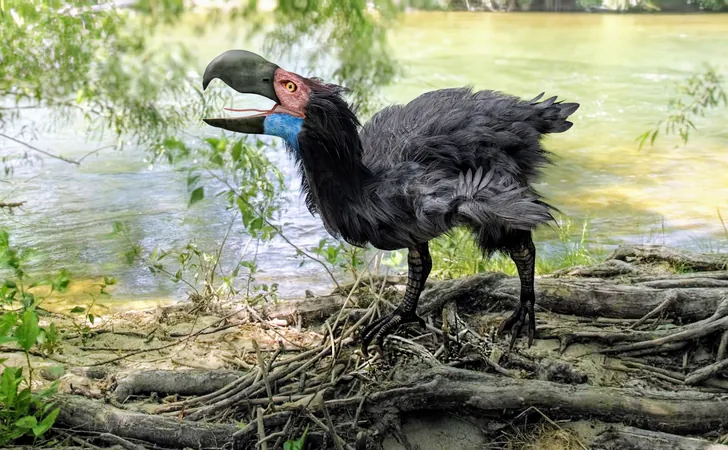
Massive 'Terror Bird' Discovery Sheds Light on Ancient Predators That Ruled the Earth
2024-11-07
Author: Jia
Unpacking the Phorusrhacids
Known colloquially as "terror birds," Phorusrhacids were among the most impressive predators to ever walk the planet. These flightless birds roamed South America for approximately 60 million to 2 million years, standing as tall as 10 feet. Their massive, hooked beaks and powerful legs were perfectly designed for running, allowing them to dominate their ecosystems.
Hunting small to medium-sized prey at remarkable speeds, these birds utilized their lethal strikes to capture food, effectively filling the ecological niche left empty by the extinction of dinosaurs. Some scientists even suggest that terror birds may have hunted in packs, although this remains a topic of debate.
A Key Fossil Finding
Central to this fascinating tale is a leg bone discovered from the Miocene epoch, approximately 12 million years old. Dr. Siobhán Cooke, an associate professor specializing in functional anatomy and evolution at Johns Hopkins University, has spearheaded the study of this remarkable find. He emphasized that the bone's size indicates this terror bird could be the largest member of its species yet identified, ranging from 5 to 20 percent larger than previously known Phorusrhacids.
Intriguingly, the fossil exhibits distinct characteristics, including deep pits typical of Phorusrhacids and potential bite marks from a prehistoric caiman, Purussaurus, suggesting a fierce encounter before the bird's demise.
Expanding the Terror Bird's Territory
This recent discovery expands our understanding of the geographical distribution of terror birds beyond their traditionally recognized regions of Argentina and Uruguay to as far north as Colombia. The insights gathered indicate a highly diverse and thriving ecosystem, contrasting sharply with today's arid landscapes.
During the time these ancient birds thrived, the environment was richer, populated not only by terror birds but also by primates, massive ground sloths, gigantic glyptodonts, and other unique creatures. Today’s seriema, a long-legged bird found in South America, is a distant relative of these ancient predators.
Revisiting the Ancient Ecosystem
The study of Phorusrhacids opens a fascinating avenue for understanding past biodiversity and ecosystems. With the potential for more undiscovered fossils in museum collections, Dr. Cooke highlights the necessity for further exploration. Many fossils might not yet have been identified as terror birds due to their less distinct characteristics.
Imagining the landscape 12 million years ago evokes a vivid image of a vibrant ecosystem teeming with life – a world where one could encounter bizarre and extinct animals.
The Legacy of Terror Birds
The newly discovered fossil illuminates the evolutionary trajectory of apex predators. The terror bird's robust leg bones and sharp beaks signify natural adaptations that enabled it to thrive. Insights from their evolution can inform scientists about how apex predators adapt to environmental changes, providing essential knowledge for the field of evolutionary biology.
A New Era of Discoveries?
This significant finding in the Tatacoa Desert raises excitement within the paleontological community about the potential for further fossil discoveries in Colombia — a country that has not been regarded as a major site for such finds. Recent evidence points toward a hidden paleontological treasure, paving the way for a deeper understanding of Miocene ecosystems.
Researchers remain optimistic that further exploration will reveal more about these ancient creatures, helping construct a clearer picture of their behaviors, habitats, and interactions within their environments.
This study has been published in the renowned journal Palaeontology, paving the way for future discoveries that might unlock more secrets from the time when terror birds ruled the land.



 Brasil (PT)
Brasil (PT)
 Canada (EN)
Canada (EN)
 Chile (ES)
Chile (ES)
 España (ES)
España (ES)
 France (FR)
France (FR)
 Hong Kong (EN)
Hong Kong (EN)
 Italia (IT)
Italia (IT)
 日本 (JA)
日本 (JA)
 Magyarország (HU)
Magyarország (HU)
 Norge (NO)
Norge (NO)
 Polska (PL)
Polska (PL)
 Schweiz (DE)
Schweiz (DE)
 Singapore (EN)
Singapore (EN)
 Sverige (SV)
Sverige (SV)
 Suomi (FI)
Suomi (FI)
 Türkiye (TR)
Türkiye (TR)